The high mass of the floor screed allows for its excellent ability to accumulate heat. This feature is especially beneficial when our heat source is not running constantly. This is the case, for example, in the case of fireplaces with a water jacket, solid fuel boilers, electric boilers using cheaper electricity in the night tariff or heat pumps. We present the most important aspects to consider when planning an underfloor heating system in your home.
If the amount of stored heat is large enough and heat losses are low, the conditions inside the building are comfortable. In such cases, it makes no difference whether the heat source is working or not. In the transitional seasons of spring and autumn, when the heat demand is low, sometimes it is enough to turn on the heating only once every two or three days.
Slower retraction and lasting warmth of an underfloor heating system
The increased heat storage capacity also has some disadvantages. Controlling the temperature in the rooms becomes difficult because the underfloor heating reacts slowly to changes. Traditional methods of control, such as night temperature reduction, do not work practically. When the hot water supply is turned off, the temperature in the floor drops slowly and steadily, not instantaneously. This ensures that the floor will continue to give off heat for a long time after the water supply is turned off.
Regardless of these features, there are many methods and technologies that allow you to achieve optimal performance of underfloor heating. Mixing systems can be used to lower the floor supply temperature, room thermostats or weather automatics can be used to regulate the water temperature.

It is also worth paying attention to the modulation of the power of heating devices. In most of the heating season, we do not need the maximum power of the boiler or heat pump. Therefore, it is important that these devices have the ability to reduce power to match the actual heat demand.
All aspects of the floor heating system should be taken into account when designing and selecting the system to ensure optimal thermal conditions in our home and at the same time achieve the highest possible energy efficiency.



